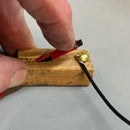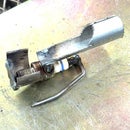Introduction: Toy Mack AC Bulldog Truck - Part 3
This Instructable will discuss some fine touches to the Mack AC Bulldog toy truck, like a crank, faux chain drive, and steering wheel. The first in this series can be found here.
Early trucks used a chain drive. The differential was mounted high in the truck frame, not between the rear wheels. I decided to make the appearance of a chain drive, but there are no moving parts in it. You can see it on the left side of the photo near the rear wheel.
Step 1: Make the Chain
I used 1/8 inch rod for the facsimile chain. One end was bent around a 1/2 inch rod. The other end was bent around 3/4 inch water pipe. I planned so the ends would meet above the rear axle on the truck. This area needs to be welded to the frame of the truck, anyway. It will be in a place where it really does not show.
Chain hangs between two supporting points in a gentle curve. I tried to bend the 1/8 inch rod to replicate the natural curve in a chain hanging between two points.
Step 2: Weld the Chain to the Truck Frame
I spread the ends of the rod that makes the chain and slipped it over the rear axle. Then I welded the ends of the chain together before welding the chain to the frame. The photo shows the ends of the chain held together on a piece of flat aluminum by two spring clamps. The chain is around the rear axle between the wheel and the frame.
There is no rear sprocket for the chain. The chain simply hides behind the rear wheel where a sprocket would not be clearly seen, anyway. Position the chain for a pleasing appearance and tack weld it to the frame near to where you welded the two ends of the rod together.
Slice a piece of 1/2 inch rod to replicated the front sprocket. Place it inside the rounded front end of the chain. Weld the slice of 1/2 inch rod to the frame of the truck. Let some of the weld bead catch the chain, but try to keep the weld from being visible from the side of the truck that will be seen. (Look again at the introductory photo and the second photo above.)
Step 3: Steering Wheel
The Mack AC Bulldog truck had a cast iron steering wheel with five spokes.
I cut short pieces of 1/8 inch rod for the steering wheel spokes. I used a marker pen to draw a 72 degree angle on the piece of aluminum I use to hold small parts for welding. I welded two short pieces of rod at 72 degrees. Then I moved them and welded a third short rod at 72 degrees away from the last piece of rod. Small errors creep in. I also eyeballed the spacing between the rods as I got to the fourth and fifth pieces of rod.
I bent a 3/16 inch rod around a 3/4 inch water piece, cut the ends, and welded the ends together to make a ring that is the steering wheel. I had to grind it smooth and I had to pound on it to remove any flat spots in the steering wheel.
In the photo you see the steering wheel placed over the five rods welded together for the spokes. I marked the spokes and cut them to length so I could fit the wheel over the five spokes. I welded the spokes to the wheel.
Step 4: Drill the Center of the Steering Wheel
The welded area where the five spokes meet in the center of the steering wheel was large enough that I could drill a 3/16 inch hole through it for the steering column mentioned in Instructables #2 in this series.
Step 5: Weld the Steering Wheel to the Column
I cut the steering column to length. (This was easier to do after building the engine cowl and the radiator, which is behind the engine on these trucks) I slid the steering wheel onto the steering column and welded them to each other from above. (The photo shows the engine cowl and radiator already in place. Those will be described later.)
Step 6: The Crank
The graphic and the photo show the details on how the crank is mounted. There is a hole through the frame for 1/8 inch rod. I bent the crank first. Then I inserted it through the hole. I added a collar and welded it in place. Then I welded a piece of 1/8 inch bar to the frame bent as shown to keep the crank from sliding backward into the frame.
The next Instructable in this series can be found here.





